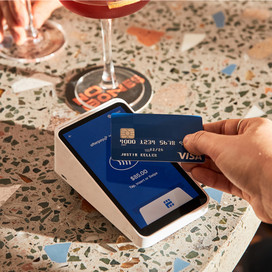Table of contents
At the surface level a business can appear quite simple. Step one: sell a product or provide a service. Step two: get paid.
Unfortunately, step two can fast become the bane of a business owner’s existence. But it needn’t be – if you want to ensure that fair work results in fair pay, you simply need to dot all the Is and cross all the Ts.
Let’s take a closer look at payment terms – the invoice terms and conditions that can safeguard you and your business against parties who may fail to pay you on time.
What are invoice payment terms?
Before we get into the why and how of terms of payment, we should first understand the what. So what exactly are invoice payment terms?
Payment terms are a set of invoice terms and conditions, outlined by the seller and agreed upon by the buyer, that state exactly how and when payment will be made and the penalties that might be incurred if terms aren’t met. Invoice payment terms can include the following information:
- The invoice date.
- The total payment due.
- The payment due date and/or the period of time the customer has to pay.
- Stipulations for a deposit or advance payment (where relevant.)
- Payment plan details (where relevant.)
- Payment instructions and a list of acceptable payment methods.
- Potential actions to be taken if payment terms aren’t met.
Payment term transparency ensures that all parties are on the same page from the get-go. It removes potential excuses that a customer might have otherwise used down the track. Terms of payment must therefore be included on every invoice you generate.
Why are payment terms important?
Payment terms are critical for your business as they give you clarity and control over your cash flow. You can be confident of how much money is coming in and when it will arrive, granting you the ability to make accurate financial projections, plan for taxes, run your business smoothly and fuel ongoing growth.
This is all the more critical when you consider that 80% of small business owners stress about their cash flow and over 50% of those with cash flow issues cite late customer payments as the primary cause.
In instances where your invoice terms and conditions are breached, you can be confident of recouping that money, as your payment terms can provide you with a watertight case in any payment chasing, debt collection or litigation processes. That said, the aim of invoice payment terms should be to make things so clear cut that you avoid facing these situations altogether.
How do payment terms work?
To get a sense of how payment terms work and why they’re important, it’s helpful to imagine a real-world scenario.
Imagine you’ve gradually grown a small side hustle into a proper business. You’ve outgrown your garage and have decided to invest in opening a shopfront on your local high street. You need to fit out the shopfront with around $10,000 of fittings, fixtures, furnishings and equipment, but you don’t have the capital on hand. Good news: a customer has just placed an order for that exact amount!
You lock yourself into your lease and prepare for your opening. But there’s a problem – the customer hasn’t paid when you expected them to. You find yourself paying rent on an empty space, without any way to generate income from it until your customer sees fit to pay you.
This is the sort of situation that clear payment terms can help to avoid. By clearly outlining your payment terms from the very beginning of the customer relationship, and reiterating those expectations on every invoice you send, the customer is far less likely to pay late. Sure, late payments will still happen, but not because of anything you’ve done.
If the customer continues to avoid making payment, you’ll have all the evidence you need to collect the money that is owed.
7 types of invoicing and payment terms
What terms will you choose to offer your customers? While the decision is largely up to you, it will also need to reflect the needs of your business, the wants of your customers and the accepted practices of your industry. For example, a fashion outlet doesn’t need to offer 30-day payment terms, while a supplier of large industrial equipment will find it difficult to enforce immediate payment terms.
Some of the more common payment terms include:
- Prepay/pay in advance (PIA): You take payment for products/services before you supply them.
- Deposit/advance payment: You take payment before you supply based on a percentage of the total (10%, 25%, 50%) and collect the outstanding amount when you supply the product/service or at a later date.
- Pay on receipt: You take payment as soon as you supply the goods, services or invoice.
- 7, 14, 30, 60, 90-day terms: You take payment within a certain timeframe that begins with the supply of the goods, services or invoice (commonly between one week and three months.)
- Instalment agreement: You take payment via regular instalments over a predetermined timeframe.
- Subscription/retainer: If a customer continually uses your products/services, you can charge them monthly or annually.
- Early payment incentive: You offer a discount to those who pay early, e.g. a customer who has 30-day payment terms, but pays within seven days.
State your preferred payment methods
One of the most important components of your invoice terms and conditions will be your preferred payment method. Like the payment terms listed above, you choose the payment methods you accept, though you’ll have to consider the needs and wants of your customers and the norms of your industry.
Payment methods include:
- Cash
- Credit/debit card
- Contactless payments
- Bank transfer/direct debit
- BPAY
- Afterpay/Buy now pay later (BNPL)
- Cheque
There are also a number of ways you can take each of these payments, including:
- In-person: If you run a shopfront, market stall or another form of customer-facing business, you’ll more than likely need to accept in-person payments. Taking payments is easy with Square’s complete range of hardware solutions, from portable e-readers to EFTPOS machines to complete POS solutions.
- Remote: Perhaps you accept payments after your goods and services are supplied. Perhaps you supply your products through the post or your services over the internet. If you need to take payments remotely, Square Virtual Terminal has you covered, allowing you to get paid from anywhere.
- Via invoice: If you allow your customers to pay within a predetermined timeframe, you’ll need a tool capable of tracking these payments and ensuring you’re getting paid when you’re supposed to. With the ability to set everything from recurring payments to automated reminders, Square Invoices makes invoicing a breeze.
7 invoicing tips to get paid faster
Too many businesses spend too much time and energy chasing money. The following seven tips can help you avoid overdue invoices altogether.
1. Make your payment terms clear from the outset
Go through your payment terms with a new client, and ensure they understand and agree to their part of the bargain. This removes perhaps the most common excuse in the playbook: ‘I didn’t realise’. This also gives you the chance to get a sense of whether they’ll be a good client – if there’s apprehension at this early stage, it doesn’t bode well for the future.
2. Make your invoice clear, simple and easy to digest
Confusion creates payment delays. List every item with a clear description. Put the most important payment information in bold. Remove any unnecessary clutter from the invoice and put your name and logo pride of place so that the customer knows it’s yours. It also helps to put a friendly note at the bottom: “Thanks for your business!”
3. Avoid surprises by tracking costs as you go
Sometimes a product or service might be more expensive to supply than you initially advised. If an invoice is larger than a customer expects, they might push back on your payment terms. To avoid these surprises, keep a running record of your costs, and advise your client as soon as you find yourself going over budget.
4. Address the invoice to an individual
You’re more likely to get paid on time if the responsibility falls on the shoulders of an individual. Address your invoice to the appropriate person – in B2C this is usually whoever asked for the product or service, while in B2B this is usually the person in charge of accounts payable. If you’re not sure who you should address the invoice to, give the customer a quick call!
5. Generate an invoice as soon as you (reasonably) can
The sooner a customer receives an invoice, the sooner that customer can proceed with their payment processes. They may also attach more value to your goods and services soon after they’re supplied, versus weeks or months down the track. Generate invoices as soon as possible or set up an automated recurring invoice.
6. Keep in constant contact
The squeaky wheel gets the oil, or so the saying goes. Keep in constant contact with your customers, when the payment period has nearly expired, when payment becomes overdue, and regularly from then on. Make a phone call, as they are far harder to ignore than an email. A tool like Square Invoices can automate much of this work, taking the weight of chasing payments off your shoulders.
7. Charge fees for late payment
If you’ve done all the above, you’re well within your rights to charge fees on overdue amounts – it’s a form of interest, just as you would pay a lender monthly interest on the money you owe them. It should be said that this isn’t a common path to go down, and as such your clients might offer up some terse feedback, but if you do choose this course of action you can always remove the fees once payment has been made.
No matter when or how you ask your customers to pay, you need tools and equipment capable of accepting those payments. At Square, we offer a complete range of payment solutions that let you run your business your way.
If you’re a business owner looking to capitalise on every opportunity that comes your way, cater to as many customers as possible, and ensure your customers pay in line with your terms, Square’s complete suite of hardware and software solutions is ready to help.
![]()











